The cruiser "Varyag". Fight Chemulpo 27 January 1904 of the Year. CH 15. Reports V.F. Rudneva
Almost everyone interested history naval fleet, note many oddities in the report of the commander of the "Varyag": many of them did not look like that before the Japanese documents were made public, but after that ... it seems that Vsevolod Fedorovich lied literally at every step.
In fact, the final point on many questions can not be put today, at least on the information that has been revealed to us by historians in the Russian-language publications. But first things first.
So, the first very large strangeness is the record of the Varyag logbook, almost literally later quoted in the report of V.F. Rudneva about damage to the steering of the cruiser: "12 h. 5 m. Having passed the traverse of the island," Yo-dol-mi "was interrupted by a cruiser pipe in which the steering gears passed." In addition, the report to the Viceroy also contains such a phrase “The control of the cruiser was immediately transferred to the handwheel in the steering compartment, since the steam pipe to the steering machine was also interrupted.”
All would be nothing, but the same AV Polutov writes: ““ Varyag ”was raised on 8 August 1905 and 12 August anchored in Fr. Sovolmido, after which the cruiser examined in detail all the devices and mechanisms of the power plant, propeller-steering group, etc., no combat damage was found. October 10 X-NUMX. Rear Admiral Arai sent a telegram to the Minister of the Sea in which he reported:
That seems to be the case that VF Rudnev rubs his glasses to his superiors, and in fact the steering gears remained intact. But is it?
Unfortunately, it is completely unclear on what basis the respected A.V. Polutov concluded that there was no combat damage to the propeller-steering group. After all, in the telegram of Rear Admiral Arai he quoted, there is nothing like that. Arai writes only that the steering device allows the ship to make an independent transition - and only. But the information indicated in the report of Vsevolod Fedorovich does not contradict this at all! V.F. Nowhere does Rudnev say that the cruiser has completely lost steering, he writes only about the loss of the ability to steer from the wheelhouse. Recall the description of V. Kataev: “The steering was carried out either from the battlefield or from the wheelhouse; in the event of their failure, the management was transferred to the steering compartment, located under the armor deck. " This, according to the report of the commander of the Varyag, happened - the management was transferred to the steering compartment, but of course, it was inconvenient to use it in battle. The control post was inside the ship hull, and even in the stern, of course, it was very difficult to shout from the conning tower: the connection was obviously provided, but it was very difficult to disassemble the orders in the rumble of the battlefield. “With thundering shots, the orders to the steering compartment were hard to hear, we had to be driven by machines,” as VF writes about this. Rudnev.
However, in peacetime, when nothing prevented the transfer of orders from the helmsman to the steering compartment, it is obvious that the control of the cruiser was not a problem, and could be carried out even from the military, albeit from a wheelhouse. That is, the absence of the steering column in the conning tower could in no way prevent the cruiser from proceeding on its own after it was raised. Thus, we see that in the words of Rear Admiral Arai and VF Rudnev no contradiction.
In addition, we must not forget that, according to the report of the commander of the cruiser, the damage occurred after a projectile hit near the Varyag cabin. It is possible that the concussion of the explosion led to some minor malfunction of the steering column, at the level of the detached contact, which would be relatively easy to eliminate (if you knew what it was, because, in general, communications stretched across the ship) , but which led to the inoperability of the column in battle. It is unlikely that such damage could have been regarded by combat engineers as Japanese. And you need to understand that the words of the Japanese about the health of the mechanisms are very relative. It is very difficult, for example, to imagine how the Varyag electric steering column could be fully operational after the cruiser had spent more than a year and a half in seawater.
The author of this article assumes that the Japanese specialists were completely indifferent to the torment of historians who will live a lot after them. They probably approached the matter more simply: if there is a clear physical damage caused by a projectile hit, or by a fragment, rupture, or fire, then they considered such damage to be combat. If some unit had none, then such damage was not considered combat. And could it happen that the same steering column, not working in combat, was corrected in the course of the listed AV Half-dark works: “The steering device was checked and adjusted. Communication equipment repaired ... "?
In general, in order to put an end to this issue, it is necessary to work very seriously with Japanese documents: today, Russian-language sources do not provide exhaustive information that allows you to unambiguously catch V.F. Rudneva lies about the damage to the steering of the cruiser.
But with artillery things are much more interesting. So, in the cruiser logbook we read: “The following shots were shot down by 6” gun number 3 ”and further:“ The fire came from a shell that exploded on deck while being shot down: 6-dm guns №№ VIII and number IX and 75-mm Tool No. 21, 47-mm Tool No. 27 and 28. ". In total, according to the reports, 3 six-inch, one 75-mm and four 47-mm guns hit by the enemy, and then the logbook, and VF reports. Rudnev indicate:
1. All 47-mm guns are unsuitable for shooting.
2. Another 5 6-caliber guns caliber received various serious damage
3. Seven 75-mm guns are damaged in knurls and compressors. "
But that's not all, because in his memoirs Vsevolod Fedorovich additionally indicated among the destroyed 6-dm guns No.4 and 5, as well as 4 75-mm guns No.17,19,20 and 22. In total, according to V.F. Rudnev, the Japanese were hit by 5 152-mm and 75-mm guns and 4 47-mm guns, and in addition, 5 152-mm, 7 75-mm and 4 47-mm artillery systems were damaged.
And all would be fine if it were not for one “but”: the Japanese, after the death of the “Varyag” and in the course of the ship-raising works, removed all the artillery from it. All 12 152-mm cruiser guns were sent first to Sasebo, and then to Kure naval arsenal. In this case, the artillery plant, which carried out the inspection of guns, declared them all fit for use.
So, it turns out, V.F. Rudnev lied? It is quite possible, but let us recall the state of the artillery of the cruiser “Askold” after the battle and the 28 breakthrough in July 1904.
During the battle on the cruiser, the 6 152-mm guns out of the 10 available on it (two more were left on the forts of Port Arthur) failed. In this case, the three artillery arms were bent, while the lifting gear of each gun was broken from 2 to 5 teeth. In the fourth gun, the lifting arc was also bent, but in addition to this, the balls of the turning mechanism were damaged, the flywheels of the lifting and turning mechanisms were broken, the sight was damaged, and a metal piece was knocked from the target box. Two more guns were completely intact, but as a result of close explosions of shells, reinforcements failed and, at least in one case, the deck was under the gun. However, the reinforcements for one of these guns were quickly restored, but it was put into operation on the night of July 29.
Thus, we can state that as of the end of the battle the cruiser had four six-inch guns out of ten available. This is an indisputable fact.
And now let us imagine for a second that due to some reasons of the mystical property “Askold” immediately after the battle, it was at the disposal of the Japanese, and they removed the six-inch artillery from it, sending it to the artillery factory for examination. What will be its verdict?
Strangely enough, most likely, all six guns that were disabled during the battle will be considered fit for further use. As you can see, the two guns are completely completely intact, so nothing prevents their use. Three more guns with bent lifting arcs and crumbled teeth of the lifting gear have non-combat damage to the gun machine, but not the gun itself: at the same time, the Japanese distinguished between the “gun”, “machine tool”, and “rotary mechanisms of the tool” (at least for 152-mm guns). In other words, oddly enough, the lack of any serious damage to the gun, recorded in Japanese documents, does not mean that the gun mount was operational and could be used in combat. And even on the sixth cannon, which in addition to the curved lifting arc also damages the turning mechanisms and the sight, the Japanese are unlikely to have delivered a “guilty” sentence, because, strictly speaking, the scope is also not part of the cannon. But there is still a vagueness, perhaps, the Japanese would have recognized the one and only gun as they were damaged in battle (precisely because of the sight).
And now let us estimate the damage of the “Askold” artillery by the standards of V.F. Rudnev, who, alas, did not find an opportunity to describe the exact damage to the artillery of the cruiser entrusted to him, limiting himself only to the terms “shot down” (that is, the gun was disabled by the impact of enemy fire ) or "received damage", and in the latter case could be due to both combat damage caused by Japanese fire, and failure due to breakdowns of individual mechanisms due to the weakness or ill-conceivedness of their design.
So, if Vsevolod Fedorovich would have described the damage to the “Askold” immediately after the battle, the three six-inch guns would have been described as damaged (two unharmed cannons, damaged reinforcements, and one, with damage to the sight and turning mechanisms, would lose the ability to fight Japanese fire) and three more - damaged (those that had arcs bent and the teeth of the lifting gear turned out crumbled). And he would be right. N.K. Reizenstein in his report indicated that during the battle at the "Askold" six 152-mm guns were out of service - and he was also right. A Japanese artillery plant, having examined these guns, most likely would have considered that all six are suitable for further operation (although there is a doubt about one), and, surprisingly, he would also be right, and this despite the fact that 60% was available the six-inch artillery "Askold" at the end of the battle was not capable!
Another question arises - how did the Japanese evaluate the tools that received minor damage that did not require spare parts for repair? Let us recall the description of one of such damages received during the battle of the Russian armored cruisers of the Vladivostok detachment with the ships of Kamimura (cited by RM Melnikov, "Rurik was the first"):
That is, in some cases, the gun was “destroyed”, disabled by enemy fire, but, nevertheless, it could be put into operation sometimes even directly during the battle, sometimes after the battle. Naturally, at the artillery plant it would be a foolish thing at all.
So, the author of this article has some suspicion (alas, not adequately supported by facts, so I urge you to take it only as a hypothesis) that the Japanese still corrected some relatively minor damage to the guns before handing them into their arsenals. The situation with the 75-mm guns of the Varyag cruiser is indirectly indicative of this, and this is the point.
It is authentically known that the Japanese removed all the guns of this caliber from the cruiser. However, the available Russian-language copies of the “Estimated statements of weapons and ammunition”, on the basis of which the guns were transferred to the arsenals, indicated only two 75-mm guns. Where are the ten more? As we know, only those guns and ammunition that were suitable for use were included in the “Assessment List”: after all, this means that 10 from 12 75-mm cruiser guns were unsuitable for further use!
It turns out very strange picture. Japanese shells hit Varyag mainly at the tip — two 203-mm shells hit behind the stern six-inch ship’s prows, another one between the nose tube and the bridge, two 152-mm shells hit the bridge, one was the Mars Grotto, and so on (the damage of the Varyag "We will describe in detail later, but for now, please take the word of the author). And in a strange way, the six-inch rims, just concentrated in the ship’s ends, didn’t seem to get any damage, but the 75-mm guns, which were mostly in the middle of the Varyag hull, failed almost everything!
It must be said that, according to A.V. Polutova, the Japanese found the domestic 75-mm guns unsuitable for their fleet because of low TTX. A respected historian wrote that the Hatiman-maru auxiliary cruiser was to receive, according to the order, six-inch 2, four 75-mm and two 47-mm guns, removed from the Varyag, but 75-mm and 47-mm guns were declared unsuitable on TTX and replaced them with Armstrong 76-mm artillery systems and Yamauchi 47-mm guns. At the same time, the Japanese cannon’s 152-mm cannons were staged anyway, and the Hachiman-maru received two such guns.
Maybe the 75-mm and 47-mm guns were not really damaged, and they didn’t get into the arsenals simply because the Japanese considered them worthless? This assumption could be similar to the truth, if not a single 75-mm and 47-mm artillery systems had ever fallen into Kure, but two guns were nevertheless transferred there.
So, according to the author, this could be the case. The Japanese removed 152-mm, 75-mm and 47-mm guns from the Varyag. They considered the latter useless and unnecessary to the fleet: therefore, they did not repair 75-mm and 47-mm guns, but wrote them off as scrap, leaving only two 75-mm guns, which, apparently, did not require any repairs. As for the 152-mm cannons, then, since it was decided that they could be used further, they received the required minor repairs and were handed over to Kure arsenals. And since the guns themselves could easily have no combat damage (machine tools and / or turning mechanisms, which were taken into account separately, could receive them), this is not mentioned in the documents. However, this does not mean that the Varyag artillery was operational after the battle.
However, there is another point noted by N. Chornovil in the report of the commander of "Pascal", captain of 2 rank Victor Sanes (Sene?), Beginning with the well-known to everyone, at least a little familiar with the history of the cruiser, with the words: "I will never forget this amazing the spectacle that presented itself to me ... ”The fact is that it contains the following description:
Here N. Chornovil (and many after him) build a whole conspiracy theory: they say that the commander of the French cruiser was a friend of VF Rudnev, therefore the commander of the Varyag persuaded him to lie to present the case in a favorable light to Vsevolod Fedorovich. However, V. Sanes let it slip: indicated that the gun number XXUMX was efficient, while, according to the report of V.F. Rudneva, it was considered lined ...
Generally speaking, the case for fighters against the myths of “this country” is exceptional: usually the refutation of Russian and Soviet sources was based on quoting foreign documents and evidence, while a priori it was thought that foreigners know better and (unlike ours) always tell the truth. But, as we can see, if a foreigner suddenly speaks in favor of the Russian version of certain events, there will always be a way to throw mud at him and declare him a liar.
In fact, the picture looms extremely strange. Yes, Victor Sanes did not hide his sympathy for the Russian allies. But sorry, with Vsevolod Fedorovich, they did not herd the pigs together and were not intimate friends, although of course, during the period that their ships were in Chemulpo (less than a month), they saw each other more than once. But the suggestion that the French officer, the ship's commander, would directly lie to his admiral, inventing what he had never been, on the basis of some friendly relations established during several (and for the most part official) meetings ... let's say, it is extremely doubtful if say no more.
Here, of course, it is worth remembering the wonderful proverb of the British: “Gentleman, this is not the one who does not steal, but the one who does not come across”. As you know, V. Sanes aboard the Varyag almost immediately after his return to the raid, and spent a little time there (about 10 minutes). And if he were the only foreigner who had been aboard the Russian cruiser, then what he would not have written in the report would have been no one to catch him in a lie. Just as we know, Victor Sanes was not the only foreigner who visited Varyag after the battle - both English, Italian, and American ships (actually French too) sent their doctors and nurses, while their help, with the exception of Americans was accepted. In other words, to indulge in unbridled fantasy would be not only unnatural for Victor Sanes (after all, honor of the uniform meant a lot in those years), but also dangerous. And, most importantly, why all this risk? What did Vsevolod Fyodorovich Rudnev win from a French report? How did he even know that the report of V. Sanes would be publicized, and not be put on the shelf and never see the light? How did he know V. Sanes himself? Suppose V.F. Rudnev actually decided to sink the still fully combat-ready cruiser - but how could he know that the words of V. Sanes would come to the officers of the Naval Ministry who would deal with this matter? And why would these ranks even take into account the report of a foreign commander?
Further. If we already assume that V. Senes wrote his report under the dictation of V.F. Rudnev, it is obvious that the more accurate the details, the more faith would be in this French document. Meanwhile, we read: "The broken wing of the bridge hangs badly, where, they say, all the signalmen and officers who were there, died, except by a miracle that escaped a fragment in the heart of the commander." Generally speaking, Vsevolod Fedorovich was wounded in the head, which is quite far from the heart, and in addition, he was wounded by a fragment of a completely different projectile.
Or here: “The steel cruiser boats were completely shot, wooden ones were burned” - but on the Varyag there were boats with metal hulls, this was H. Crump's idea, and there is no evidence that some of them were replaced with wooden ones, and why ?
And if we agree that during a cursory examination of a cruiser, with the construction of which the French commander was unfamiliar, such errors are quite excusable, then why should we consider his remark about gun number XXUMX true? Perhaps it was not a weapon number XXUMX, and another weapon? Perhaps, he was not in charge of combat duty, but the commanders who were trying to fix the gun?
It is quite reliably known that in the report of V.F. Rudnev greatly inflated the loss of the Japanese. But, again, how? With reference to foreign sources. And these sources, these were still fantasy, it is enough to recall that French newspapers wrote about the losses of the Japanese.
And after all, all this was then taken seriously - the text above is a copy of the Russian edition of the Maritime Collection, which was very authoritative in those years. So we can say that Vsevolod Fyodorovich was too modest in assessing Japanese losses - he, at least, did not drown Asamu in his report.
And here it turns out interesting: on the one hand, in the reports and memoirs of V.F. Rudnev seems to have a lot of inaccuracies, very much like a conscious lie. But upon closer examination, most of them can be explained by one or another circumstance that does not cast a shadow on the honor of the commander of the cruiser Varyag. And what is the conclusion you want to do?
The author of this article will not make any conclusion, and here's why. On the one hand, the main complaints about V.F. Rudnev can be explained. But on the other hand ... somehow there are too many of these explanations. It is one thing when some statements of someone’s report are questioned - this is normal, because it is difficult for a combatant to be impartial, among military historians there is even a saying: “He lies, as an eyewitness.” But when doubts are about half the report ... And, again, all the explanations are not reduced to strict proof of the correctness of Vsevolod Fyodorovich, but rather to the fact that: "But it could be so."
Accordingly, the author is forced to become like a blonde from a joke, who appreciated the chance to meet a dinosaur on the street as 50 on 50 (“Either a meeting, or not a meeting”). Or V.F. Rudnev pointed out completely truthful from his point of view data (in the worst case, honestly mistaken for losses), or did he nevertheless sink into conscious lie. But why? Obviously, to hide something that Vsevolod Fyodorovich himself considered reprehensible.
That's just what he wanted to hide?
Critics V.F. Rudnev announced the following in unison: the cruiser Varyag fought only for “demonstration,” fled at the first sign of a serious battle, and, returning to Chemulpo’s raid, had not yet exhausted its combat capability. V.F. Rudnev didn’t want to go into battle again, so he took a lot of damage to artillery and steering to convince the authorities that Varyag was completely incapacitated.
From the point of view of historical science, the version as a version is not worse than others. But, alas, it kills on the vine a single, but an indisputable fact. V.F. Rudnev didn’t have to convince anyone of the cruiser’s ability to operate for one simple reason: the cruiser was absolutely unfit to return to his raid. And for reasons not connected in any way with the steering or the artillery of the ship. This is obvious in the truest sense of the word - just look at the photo of the ship going to the anchorage.
There is one thing that all documents are: and VF reports. Rudneva, and the “Battle Reports” of the Japanese commanders, and the “Top Secret War at Sea” confirm unanimously. This is a hole in the left side of the Varyag, the receipt of which led to the ingress of water inside the cruiser. The Japanese report its dimensions: 1,97 * 1,01 m (almost 1,99 square meters), while the bottom edge of the hole was at 80 cm below the waterline.
It is interesting that later, before the battle of 28 in July of 1904, the squadron battleship Retvizan received a hole of similar dimensions (2,1 sq.m.). True, she was completely underwater (the projectile fell under the armor belt), but still the Russian ship was in the harbor, in the presence of quite good repair shops. The hit occurred in the middle of the day 27 July, but the repair work was completed only by dawn 28 July, while they gave a half result - the flow of water into the ship continued, because the steel sheet used as a plaster did not repeat the bends of the bead ( including from the impact of the projectile). In general, although the submerged compartment was partially drained, 400 t was pumped out of approximately 150 t, but the water remained in it, and all hope was that the bulkheads supported during the repair would withstand the movement of the ship. As a result, the Retvisan became the only ship that V.K. Witgeft allowed, if necessary, to return to Port Arthur.
Well, “Varyag”, of course, did not have time for at least some lengthy repairs, which, all the more, would have to be carried out in icy water (in the yard - January, more recently there was so much ice that moving along the raid was difficult) there was no repair shop at the side, and he himself was half the size of the Retvisan. Damage to the ship received in battle, flooding turned out to be quite extensive, and enough to bring the protractor to the above photo to make sure that the list on the port side reached 10 degrees. It might have been possible to correct this with counter-flooding, but in this case the hole would have gone even more into the water, the volume of water entering the Varyag through it would also increase so that it would be dangerous to go at any serious speed. bulkheads could pass at any time.
In general, this damage would be more than enough to recognize that Varyag could not continue the fight. Some readers, however, express doubts that this photo of the Varyag was made when the cruiser was going to the anchorage, and not when he was already sinking with open Kingston. However, the fallacy of this point of view obviously follows from the analysis of other photos of the cruiser.
As we know, the Varyag anchorage was located not far from the British cruiser Talbot (less than in two cables), which was reported by both the Russian commander and Commodore Bailey. The same is evidenced by one of the latest (before flooding) photos of the cruiser.
At the same time, in the photo above, we see the Talbot at a considerable distance, the Varyag has not approached it yet.
There is no doubt that this is the Talbot, since its silhouette (especially tall pipes with a slope) is quite unique.
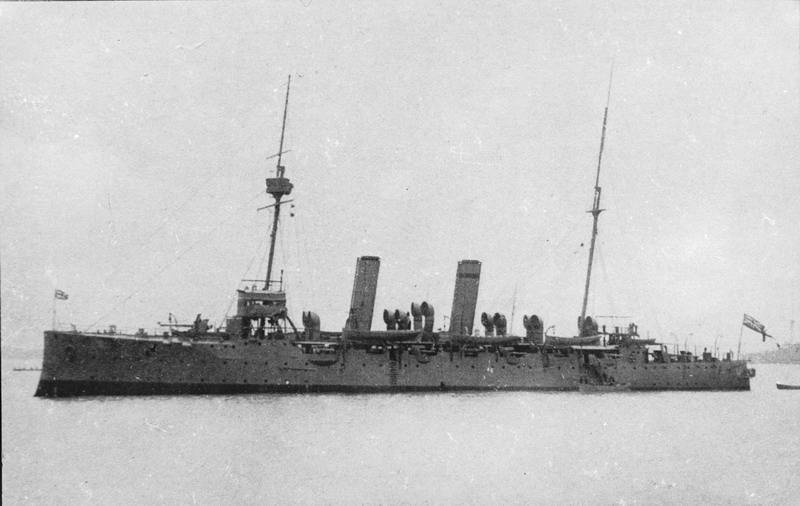
and not like the Italian "Elbe"
neither in french "pascal".
But the American gunboat was one-pipe and three-masted. Consequently, the Varyag was captured in the photograph we cited after the battle, but even before it was anchored. And the cruiser is clearly not capable.
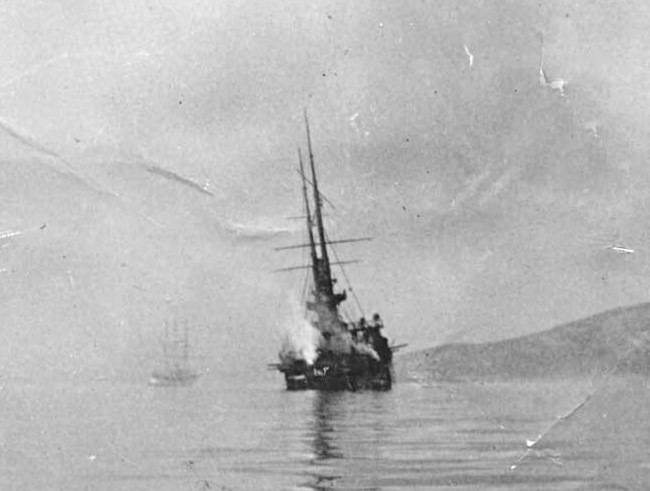
Thus, we come to an interesting conclusion. Perhaps vf Rudnev did not lie at all in his report. But, probably, he did lie, but the thing is: if the commander of the Varyag did lie, then he absolutely did not need to imitate the incapacity and so unable to continue the battle of the ship. And from this it follows that V.F. Rudnev was hiding (if he was hiding!) Something else.
But what exactly?
Продолжение следует ...
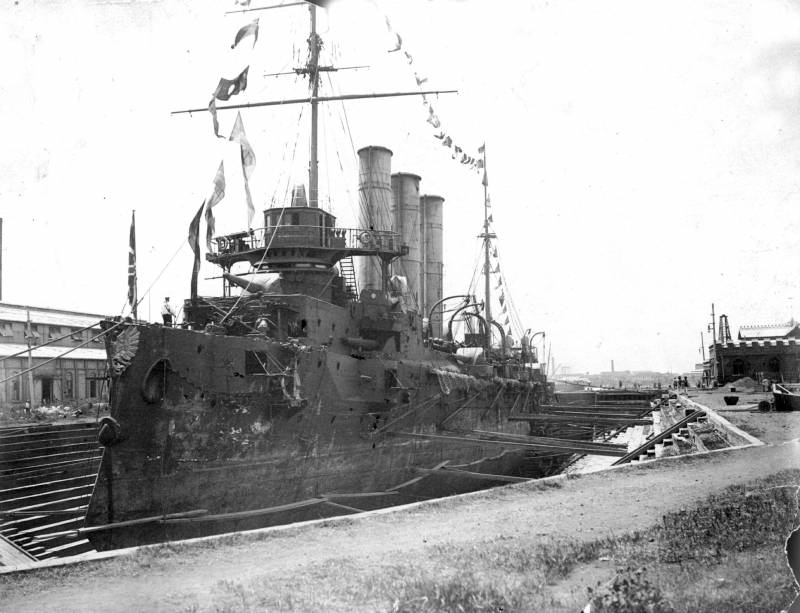
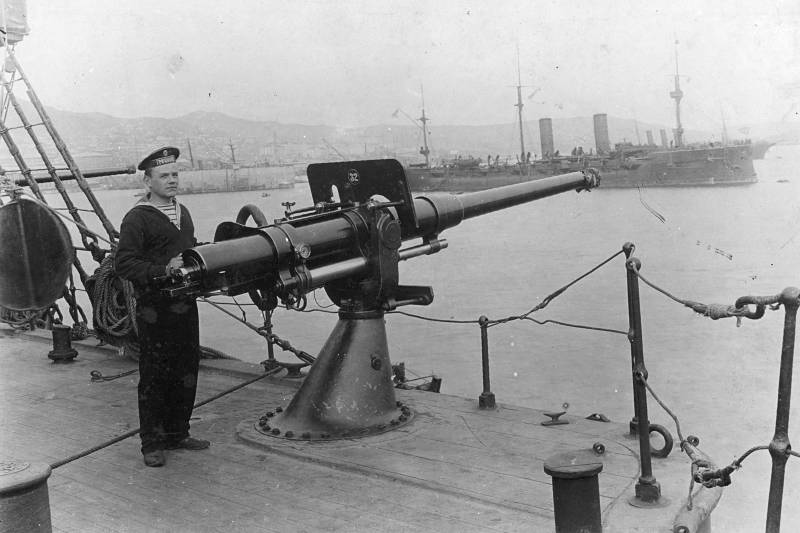
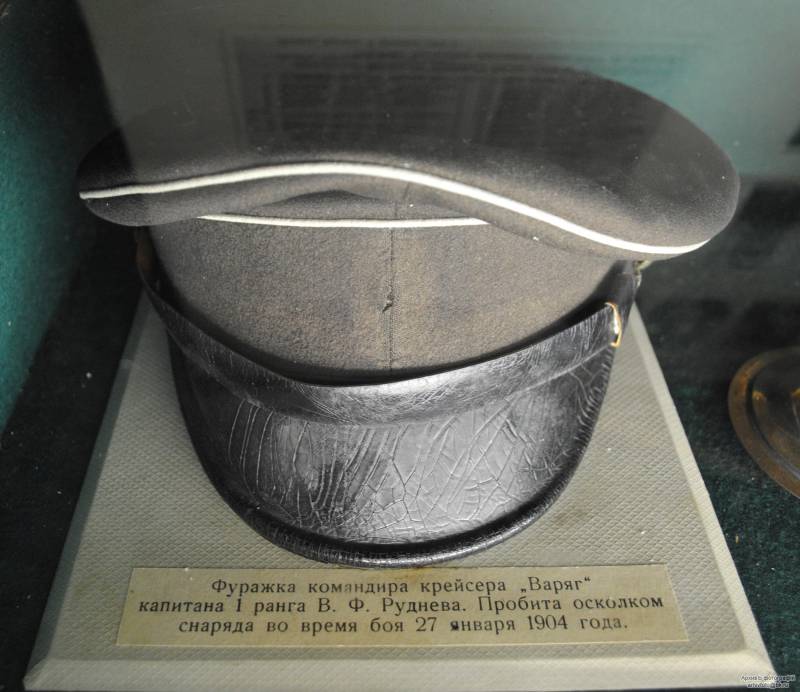
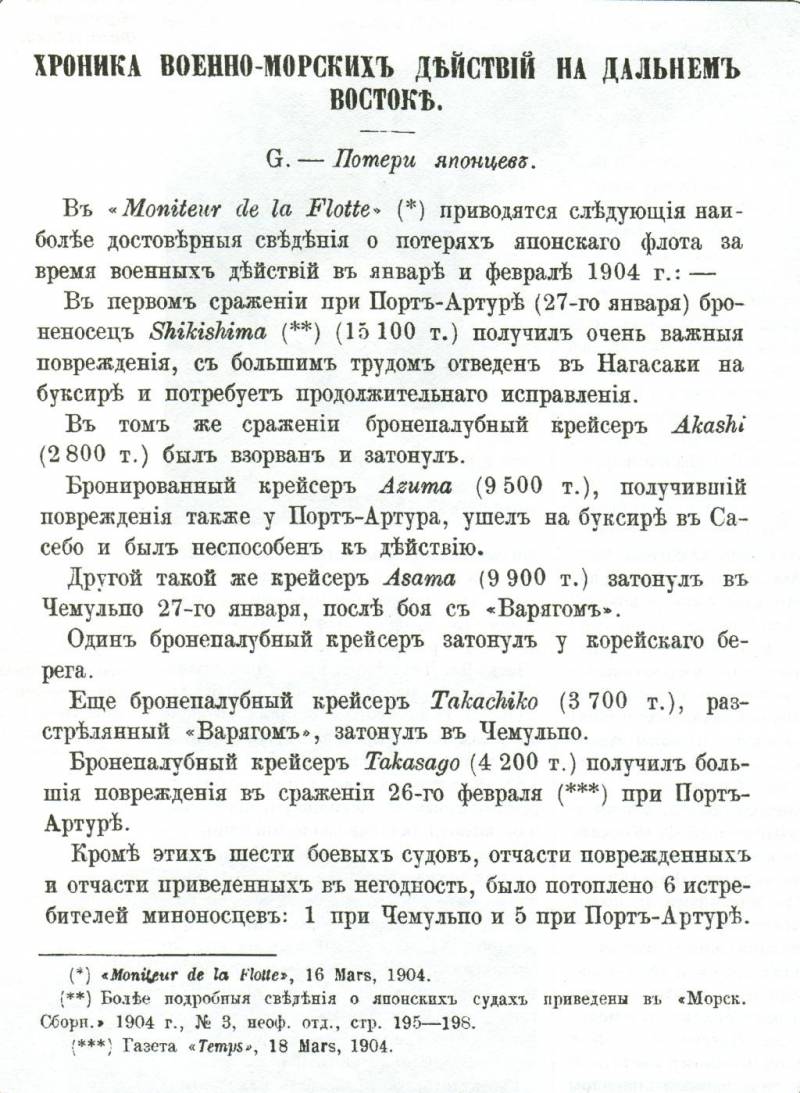
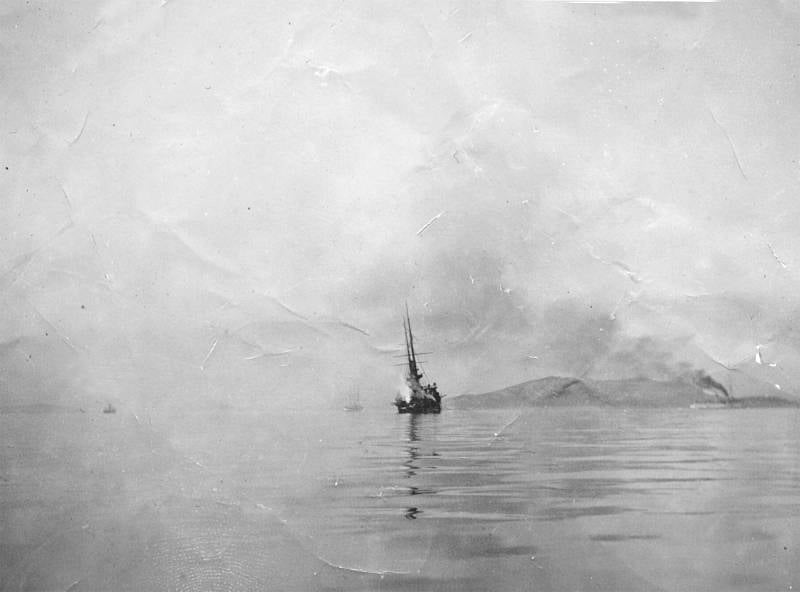
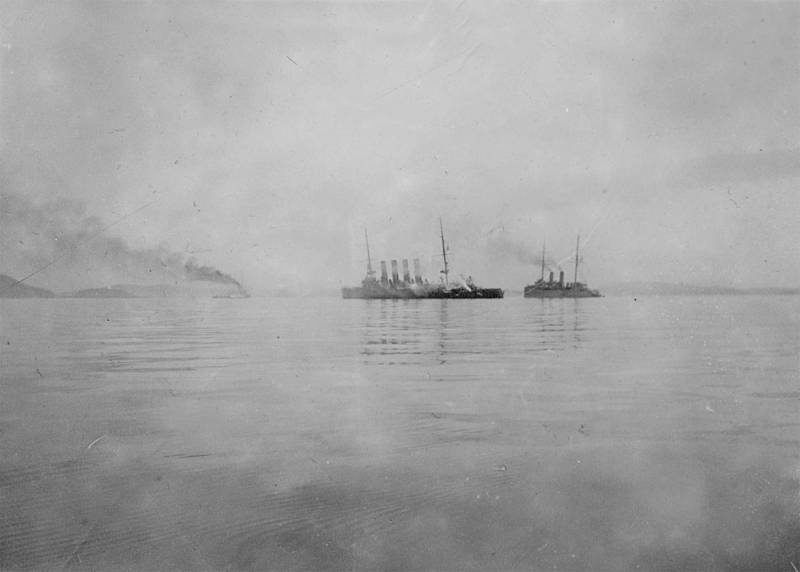
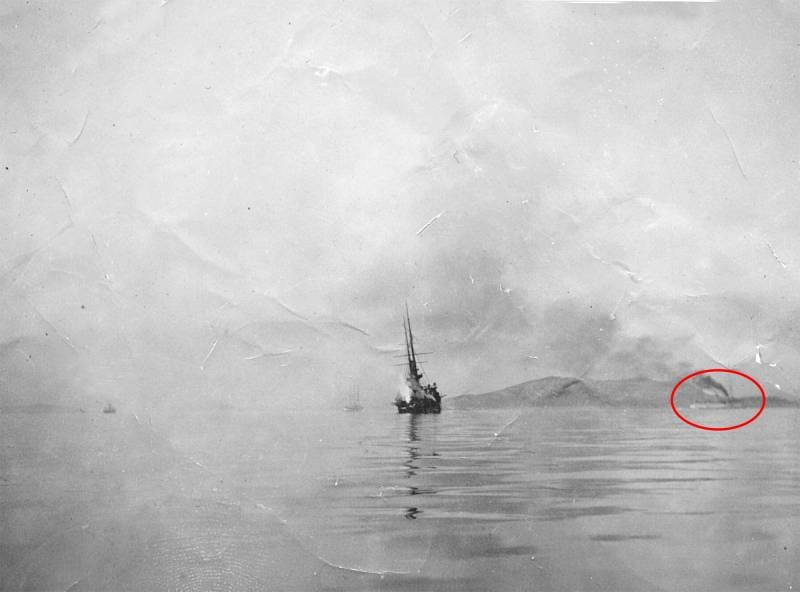
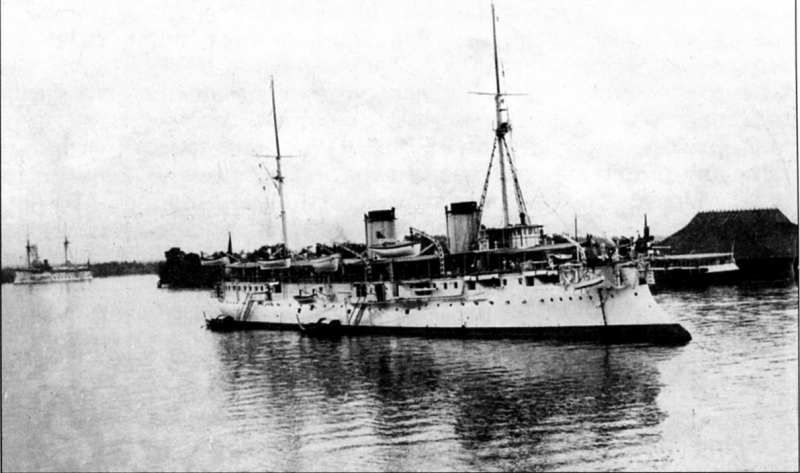
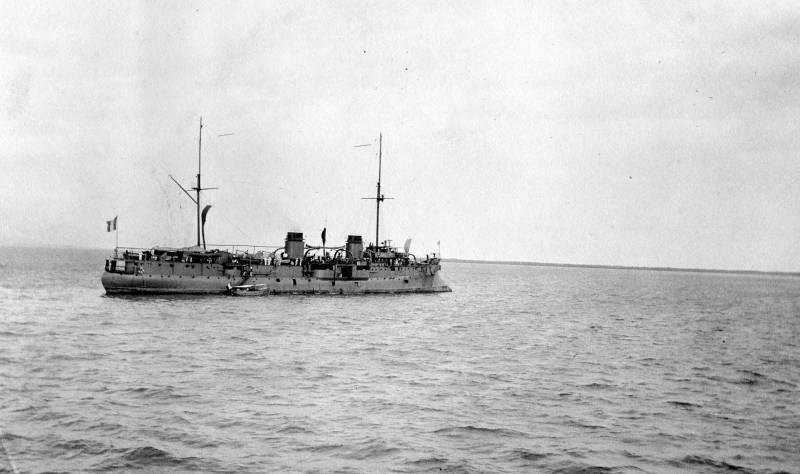
Information